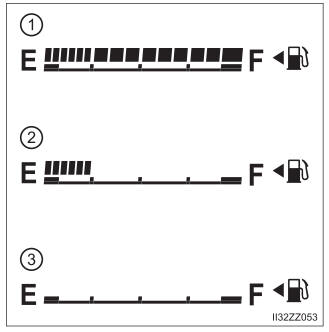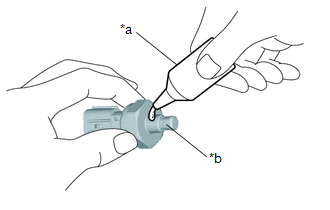Toyota Yaris: Oil Pressure And Temperature Sensor / Installation
INSTALLATION
PROCEDURE
1. INSTALL OIL PRESSURE AND TEMPERATURE SENSOR
| (a) Apply adhesive to 2 or 3 threads of the oil pressure and temperature sensor. Adhesive: Toyota Genuine Adhesive 1344, Three Bond 1344 or equivalent NOTICE:
|
|
(b) Using a 24 mm deep socket wrench, install the oil pressure and temperature sensor.
Torque:
15 N·m {153 kgf·cm, 11 ft·lbf}
NOTICE:
Do not start the engine within 1 hour of installation.
(c) Connect the oil pressure and temperature sensor connector.
2. INSPECT FOR ENGINE OIL LEAK
Click here

3. INSTALL NO. 1 ENGINE UNDER COVER ASSEMBLY
Click here

 Inspection
Inspection
INSPECTION PROCEDURE 1. INSPECT OIL PRESSURE AND TEMPERATURE SENSOR (a) Check the oil pressure and temperature sensor output voltage. (1) Apply 5 V between terminals 3 (VC) and 2 (GND)...
 Oil Pump
Oil Pump
..
Other information:
Toyota Yaris XP210 (2020-2025) Reapir and Service Manual: Reassembly
REASSEMBLY PROCEDURE 1. INSTALL NO. 2 STEERING RACK BOOT (a) Apply lithium soap base glycol grease to the inside of the small opening of a new No. 2 steering rack boot. Lithium Soap Base Glycol Grease (b) Install the No. 2 steering rack boot to the groove on the rack housing...
Toyota Yaris XP210 (2020-2025) Reapir and Service Manual: Cruise SET Indicator Light Circuit
DESCRIPTION The ECM illuminates the cruise SET indicator by sending request signals to the combination meter assembly via CAN communication. The cruise SET indicator illuminates when the dynamic radar cruise control system is controlling vehicle speed...
Categories
- Manuals Home
- Toyota Yaris Owners Manual
- Toyota Yaris Service Manual
- Maintenance
- Adjustment
- Immobilizer System
- New on site
- Most important about car
Fuel Gauge
The fuel gauge shows approximately how much fuel is remaining in the tank when the ignition is switched ON. We recommend keeping the tank over 1/4 full.


